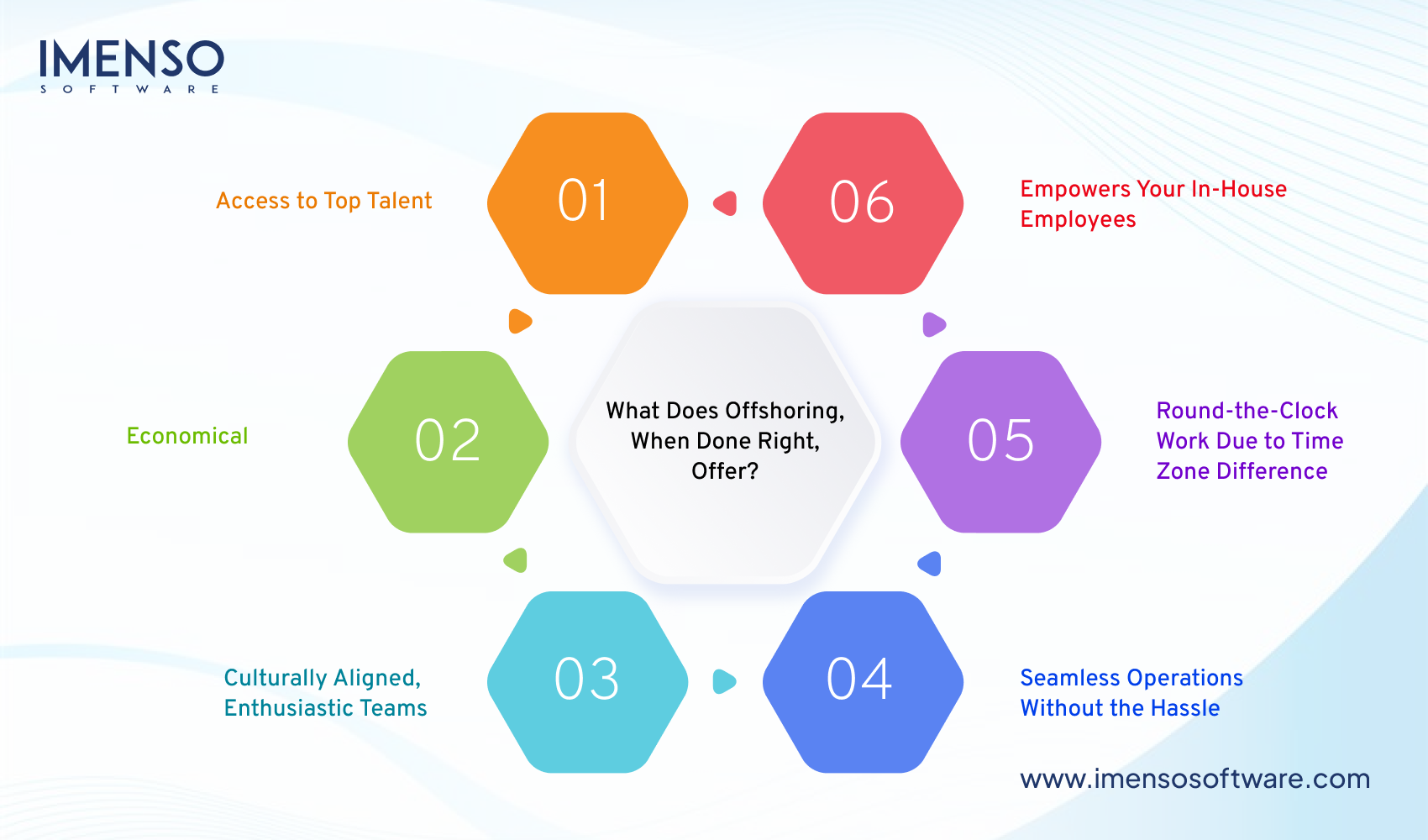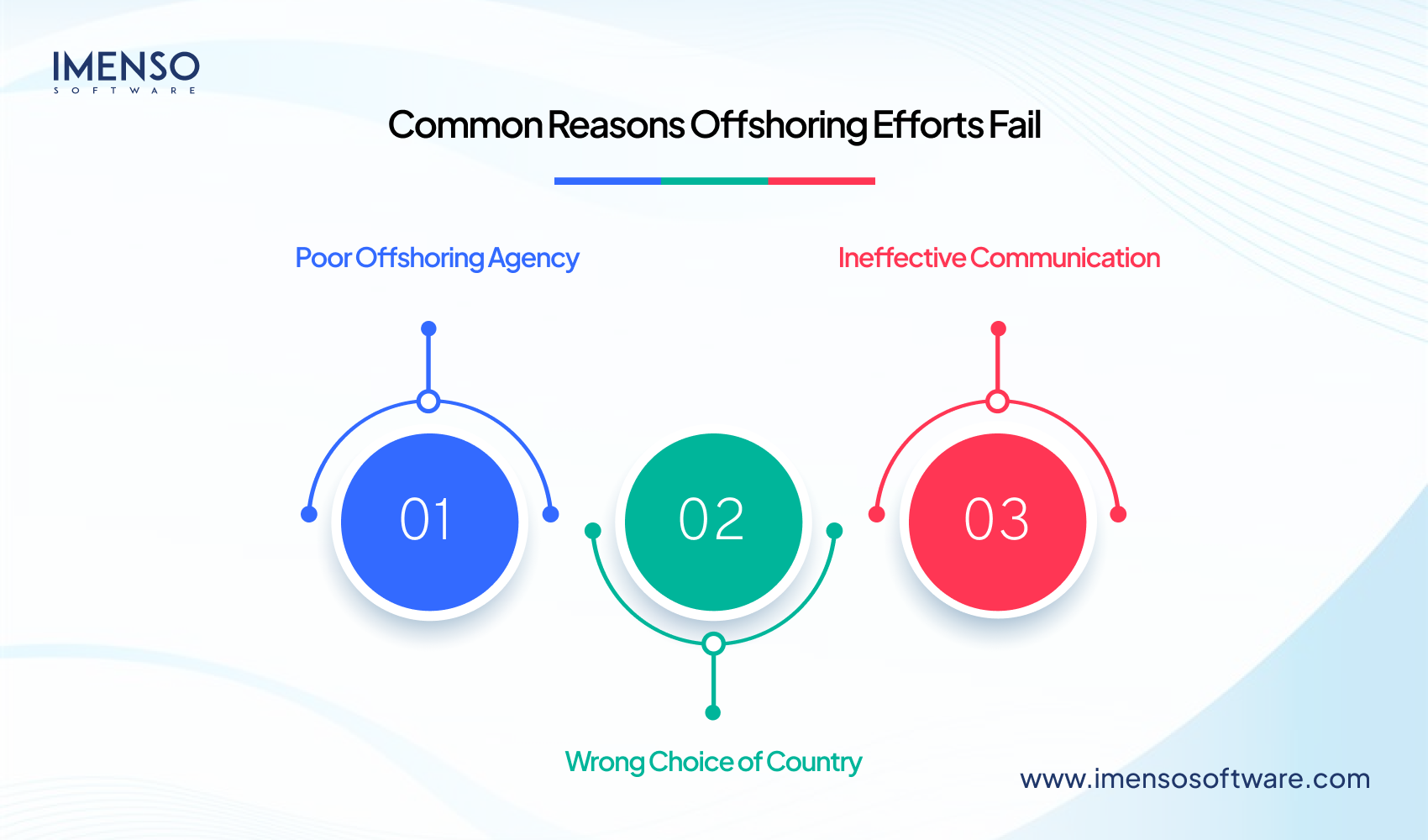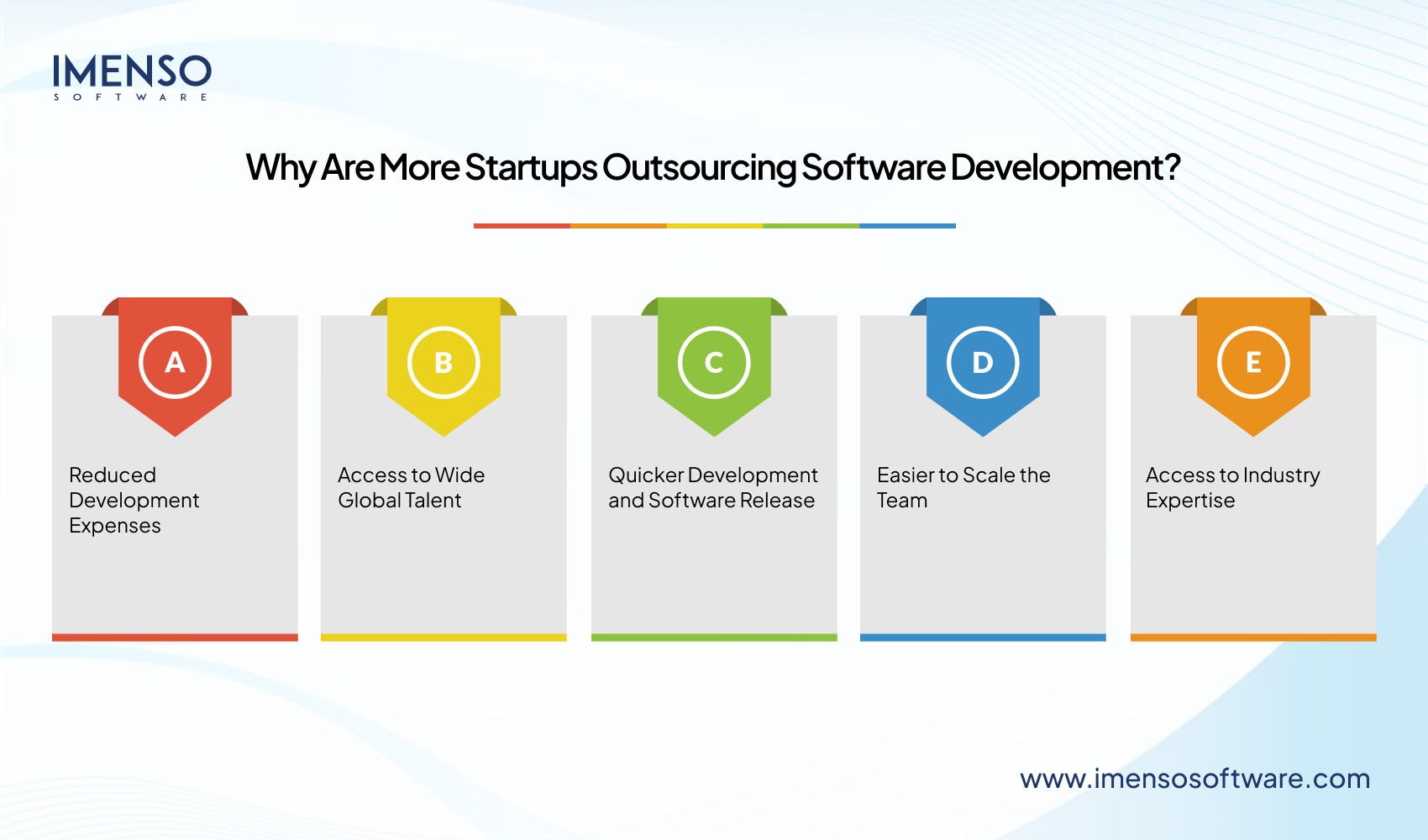Offshoring vs Outsourcing: What’s the Right Choice for Your Software Project?

Today, startups compete in a dynamic environment. To succeed, they need to balance efficiency with cost-effectiveness. Offshoring and outsourcing are two strategies that almost every startup uses to accomplish these goals. Both models leverage external talent. However, they differ from each other in various ways.
In the IT sector, both these terms are often misunderstood. This stems from their overlap. The biggest difference between them is that offshoring is an international process. But outsourcing occurs within the country of operation.
There are many more areas in which both approaches differ. To pick one, you must know these crucial distinctions. This is exactly what this blog will cover.
What Is Offshoring and How Does It Work
Offshoring is an approach where a business relocates certain services to another country. In other words, you hire a team from a distant land to build your software. You do not perform tasks related to this service in-house. The developers there perform the same functions as your in-house staff would do. All the duties related to software development are now taken care of by the offshore team.
Offshoring offers many benefits. The most notable ones are cost reduction and access to a global talent pool. But coordinating with people in another time zone can be hard.
“If you deprive yourself of offshore development and your competitors do not, you’re putting yourself out of business.”
– Lee Kaun Yew, the first Prime Minister of Singapore
What Does Offshoring, When Done Right, Offer?
Offshoring offers various benefits for businesses. Below are the ways in which it helps.

Access to Top Talent
Microsoft has its R&D centers in Bangalore. The place produces over 50,000 new engineers every year. Nations like India and Colombia have developers with niche tech proficiency. They have years of experience working for Western businesses.
But you don’t have to be Microsoft to leverage offshoring talent. Even a small FinTech wanting to extend its team can find the right talent with a good offshore development partner.
Economical
Startups in the US mostly hire offshore developers from developing nations. Here, the cost of living is much lower than in the West. So, you can hire talent at a lower rate. Consider this real-life example. A developer in the US earns around $10,888 monthly. Another one with the same skills in India earns around $3,876/month!
Not only this, but these IT specialists bring much more to the table. Their technical proficiency is seen to be much deeper than those in the Western nations. They also have the necessary soft skills, which are so critical for teamwork.
Culturally Aligned, Enthusiastic Teams
One of the common cons of offshoring is cultural misalignment. But this isn’t something that cannot be resolved. Respecting various communication styles and values ensures project success. Methods like cross-cultural training and defining clear communication rules help eliminate this challenge.
Once this is done, the offshore teams share your goals and vision. Ultimately, it gives you greater control over your team’s progress.
Seamless Operations Without the Hassle
Your offshore partner does the hard work for you. You can focus on your product and other strategic tasks. When you offshore, you build a team in a distant place. You likely do not know their legal or business-related rules.
But your offshore partner takes care of everything needed for you to set up and operate. You might be miles away from your team. Still, everything runs smoothly.
A good offshore partner handles critical tasks, from hiring to onboarding and regulation. The best ones are accredited with official security certifications. They follow strict security practices as you do in your country. Thus, you can rest assured that your data will be kept in trusted care.
Round-the-Clock Work Due to Time Zone Difference
Offshore teams have a 7-10 hour difference. This isn’t an issue. Contrarily, it works in your favor. The big time difference ensures that development happens 24/7. Your project keeps moving even while you are sleeping.
Let’s suppose you are scaling an offering. You hire an offshore team for development. When your in-house staff finishes their day, the offshore team starts from where they left off. They fix issues and continue development without delays. This gives you the benefit of quicker time to market.
Empowers Your In-House Employees
How is offshoring good for your in-house staff? Offshoring lets you distribute workload across in-house and offshore teams. This prevents your staff from burning out. Besides, communicating with the offshore team helps the onshore employees to broaden their cultural horizons.
Offshoring repetitive aspects of development frees your in-house team to focus on innovation-driven tasks. They have more mental space for thinking out of the box. All this ultimately helps your firm benefit from novel ideas.
Offshoring is a strategic enabler that boosts team performance, and productivity and enhances job satisfaction.
Common Reasons Offshoring Efforts Fail
Offshoring offers various benefits. But not every startup is able to leverage it. Below are all the reasons why

Poor Offshoring Agency
If you don’t research beforehand, you can end up with the wrong partner. Poor agencies make tall claims about what they can do. The reality is much different. They assign the developers they have to you regardless of whether they fit your needs. Partnering with such an agency makes your project go down the drain. The developers you hire must be custom-recruited to your exact specifications.
Wrong Choice of Country
You cannot just zero in on a location without much thought. It’s crucial to consider factors like the country’s infrastructure and labor costs. If even one of them is subpar, you will face issues later. Poor infrastructure makes it hard for developers to work in real time. High costs may prevent you from hiring more people. Everything impacts your project. So, it’s critical to choose the location wisely.
Ineffective Communication
An offshoring challenge that most startups face is weak communication. This is due to the time zone difference. Communication is essential for speedy and successful project completion. Not having open lines of communication between onshore and offshore staff adversely affects the quality. Cultural mismatch between both teams can also lead to poor communication.
How to Make Offshoring Work for You?
Offshoring can be a key step toward business growth. Here’s how to make it work for you.
Begin with a Small Team
It is way harder to manage a large offshore team. This is especially true for those with no prior offshore experience. You can guide a small team easily. After meeting your immediate needs, you can think about expanding the team size.
Train the Offshore Team
Remember that your offshore team lives miles away from you. You cannot expect them to be familiar with your business practices or customs. This can reduce their productivity if not handled with care. So, train your workers before they start working. Ensure that they are familiar with their duties. Tell them your project goals. Do everything possible to help them adapt to your workflow. Training is the quickest way to achieve better quality.
Choose An Appropriate Location
Choose a location after considering factors like infrastructure and labor costs. Talent availability is another critical factor. Also, find whether this nation’s regulations are favorable for foreign businesses. If one or more of these factors do not align, your project can suffer.
Manage Communication
Don’t let communication become a hurdle to your success. You and your offshore team should agree on an optimal format. You must decide on a communication method and rules from the start. For example, use emails to communicate schedules, meeting notes, and project documentation. Programs like Slack and Microsoft Teams are ideal for prompt updates. Google Meet and Zoom calls are great tools for online meetings.
Manage Business Processes
When you offshore to another country, you can lose a certain degree of control over your processes. To retain control, create clear service level agreements (SLAs). Ensure good communication and data sharing. Train your offshore team and invest in quality assurance measures. Regularly review your partnership with the team. All of it will help you retain full control over all aspects of your project.
What Is Software Outsourcing and How Does It Work
Software outsourcing involves transferring software development tasks to third-party providers. Companies give tasks like app creation, testing, and QA to the service provider. Businesses take this approach to lower labor costs and access an advanced tech stack. Outsourcing also lets them leverage the best global talent.
This approach connects startups with developers who have certain skills. They might not always find this type of talent in their home country. With outsourcing, they no longer have to integrate new specialists into their in-house team. Instead, they can focus on more strategic tasks.
“The real power of outsourcing going forward is going to be that it increases an organization’s core capacity for change and growth.”
– Michael Corbett, Founder and Chairman of the International Association of Outsourcing Professionals (IAOP)
The Difference Between Outsourcing and Offshoring
Outsourcing differs from offshoring in one crucial way. It gives you more freedom about where to hire talent. You can choose any outsourcing model. Offshoring is one of them. If hiring from a distant land doesn’t work for you, there are other approaches as well. You can choose onshoring. This means hiring a provider within your own country.
Another option is nearshore. Here, you hire specialists from a nearby country. For example, you can choose a country in the same time zone. Finally, you can use the offshore model, which has already been explained above.
Why Are More Startups Outsourcing Software Development?
There are various reasons why more startups are choosing this model. Businesses that select a good outsourcing partner benefit in these ways.

Reduced Development Expenses
Cost savings is the prime benefit. So, let’s discuss it first. Did you know that outsourcing can cut your project’s expenses by more than 50%? Cost savings occur because you don’t need to spend on training and hiring developers. There are no long-term employment commitments. Infrastructure-related expenses are almost zero.
Another critical thing to note is lower hourly rates. Startups in the US pay 5x lower hourly rates when they outsource to Asia. The lower cost lets them invest more in other areas. These include things like marketing and brand strategy.
Access to Wide Global Talent
It’s not always easy to find the right talent in the home country. Outsourcing lets you tap into a global talent pool. Businesses usually struggle to find AI, Cloud, and cybersecurity engineers with niche skills. This is especially so when they are limited by their local area. But the world is your oyster when you outsource. You’ll be surprised to find the talent available in nearby countries that you can’t find on your own.
Working with a global talent also boosts cognitive diversity. Diverse teams solve challenges quickly. They also adapt better to changes in project demands.
Quicker Development and Software Release
Quick development is another major benefit. Faster time to market means higher revenues and profits. It also gives you a competitive edge. Quick product release happens because you can begin the project earlier. You don’t have to spend time creating an in-house team. The time spent on recruitment-related tasks is cut.
Not only that, but you get specialists with niche skills. These people are custom-recruited for your project by the provider. It also quickens development.
Easier to Scale the Team
Scaling an in-house team isn’t easy. You have to go through the process of sourcing and screening so many people. This is only the start! Outsourcing, whether to a nearby nation or a far-off land, eliminates this hassle. You can simply request your provider to augment your team.
This is critical when your product is in the market and getting traction. In this case, you need to scale your team to meet the demand. Outsourcing lets you smoothly expand your team. The specialists will iterate and update your MVP. So, you benefit from more sales and revenue.
Access to Industry Expertise
This outsourcing benefit occurs only if you choose the right provider. If you work with a vendor with experience building similar products, you’ll benefit from their expertise. Their specialists will be able to deliver a high-quality product in a shorter time.
How? They already know the risks and challenges involved with such software. They know exactly how to mitigate them.
Software outsourcing serves as a key driver for lowering costs, leveraging global talent, and scaling teams quickly, without the time and expense of traditional recruitment and training.
Why Do Outsourcing Efforts Fail?
An outsourcing model can expose you to various risks. This can happen for many reasons. Below are the main causes of why outsourcing efforts fail.
Wrong Choice of Vendor
It is critical to evaluate when you are choosing a provider. Firms that lack the knowledge to pick the right partner suffer afterward. They end up getting subpar software. There are also communication issues that they face. It further hinders development. Many also fail the deadline.
Lack of Communication and Cultural Misalignment
A communication barrier is the biggest issue when outsourcing doesn’t go well. You need to communicate your needs to the vendor clearly. It ensures that the product fits the criteria defined. Many outsourcing contracts end in disputes. The reason is a communication issue between the parties.
Cultural barriers can also pose risks if not defined beforehand. Not factoring in the time zone difference also makes matters worse.
Unclear Expectations Regarding Software Delivery
Project delays are another problem that firms face. Delays are natural. You must expect them and make space for them in your timeline. But the problem escalates if you do not clearly define your delivery expectations to your vendor. It doesn’t matter how good your team is. If there is a delay in the delivery, you lose your competitive edge.
Underestimated Expenses
Outsourcing leads to cost savings. But many firms tend to underestimate the costs. This is the main reason for unfinished projects. Remember, when your project proceeds, expenses will arise. You must take them into account. It is especially so for businesses that are facing financial issues.
Loss of Ownership Rights
You pay for your software. So, you are the owner. But sometimes, teams can prefer another arrangement. They might want to retain the program’s intellectual property. Startups that do not address ownership issues in advance often face this problem. This might make you spend more time in court rather than on your project.
How to Make Outsourcing Work for You?
You don’t have to go through the nightmare of failed outsourcing. Here’s how to make it work for you.
Know the Trends to Choose a Company with the Right Expertise
Knowing the latest in software development is critical. It helps you learn about the modern tech stack in use. For example, today, AI-driven software and IoT are at the forefront. AR and VR are also raging technologies. When you know about them, you can find out if your provider uses the current tech stack. It lets you pick a vendor with the right expertise. This ensures that your finished product is up to the mark.
Define Your Needs
Get clear on what exactly you want. This will help you invest in development that will lead to a quality product. You can be more proactive at the time of choosing a partner. When you know what you want, you can convey that to your vendor. They will then find specialists custom-suited to your project.
Do a Deep Research on the Various Providers
Search for firms offering software outsourcing. You can begin by looking for companies in the top outsourcing regions. These are Latin America, India, and China.
Deeply research the companies. Find what their clients have to say about them. Check their ratings. Today, you can easily find all of this information online. You can also take advice from businesses in your niche. Filter your selection and prepare a list. Then, check their reputation. You can do so by checking their credentials and past references.
Don’t Ignore the First Impression
You can say a lot about a vendor from the first contact. Did they respond promptly? Were they available to talk? Did they give a satisfying reply to all your concerns? Did they understand your needs and challenges?
A good vendor offers various inputs and advice to resolve your challenges. They quickly understand and respond to you. In the first contact, you can also look at their tech stack. Evaluate all these things properly. It will help you choose the best company.
Choose a Suitable Outsourcing Approach
There are various outsourcing models. Pick one that best fits your needs. Choose one that lets you reach the most ideal mutual understanding related to the time and the cost. Document everything you participate in with your provider. This will let you prevent any deviation later from their side.
Clearly tell your vendor that you need regular updates about your project. Ask them about the medium of communication. Also, inquire about the channel to share and access the documents that you exchange. You can, on your behalf, invest in a project management tool. It will help you remain updated with everything related to the project.
Post-Release Support
A good provider offers support post-development. Ensure your partner provides support for at least 6 months after product launch. You will frequently encounter the need to update or maintain the software after release. At this time, your partner should be readily available to offer support.
Streamlining Software Development with the Right Model
Outsourcing and offshoring are effective approaches for software development. They benefit you from specialized expertise, lower costs, and higher flexibility. This guide will help you pick the most suitable approach for your project. Hopefully, you’ll be able to simplify your software development, making it fluid and geared to achieve a successful outcome.
Frequently Asked Questions
- 1. How do you make outsourcing work?
Find the right development task to outsource. Choose a provider after deep research. Set clear expectations from the beginning. Finally, regularly review the progress and handle challenges as soon as they arise.
- 2. Which is better, outsourcing or offshoring?
The right answer depends on your distinct needs. Outsourcing is best if you want specialized expertise and cost savings. In offshoring, you transfer development tasks to a distant nation. It can help you lower costs dramatically. The optimal model for you relies on your priorities and needs.
- 3. Is it better to outsource?
Outsourcing gives you a high-quality service at a reduced cost. If you have a tight budget or the project cost matters to you, outsourcing will prove to be better.
- 4. Who benefits from offshoring?
The business that pays for its software project benefits from offshoring. Offshoring lets you access a niche skillset that isn’t there in your home country. You benefit from specialized expertise, often at a lower cost.
Want more information about our services?
Similar Posts

10 Ways in Which Artificial Intelligence Is Revolutionizing the Financial Services Sector
Have you ever wondered how technology is reshaping the world of finance? As we navigate through the intricate web of financial transactions and investment strategies in today’s digital age, one cannot ignore the profound impact of technological innovations. From Artificial Intelligence (AI) revolutionizing risk management to Blockchain transforming the concept of trust, the financial services […]...

Average Time to Build a Website from Scratch in 2023
Whatever the field, a company’s online presence has a big impact on how successful it is. Many businesses still seem to be neglecting the fact that the majority of their customers tend to visit their websites before making a purchase. A strong online presence, particularly a website, can be crucial for increasing revenue. If your […]...

The Pros and Cons of Nearshore vs. Offshore Dedicated Developers
The modern business landscape is highly digitized. Startups wanting to make their mark need the world’s best talent. The best way to access it is through software development outsourcing. Firms offering outsourcing services have become valuable partners for businesses today. They enable startups to develop top-notch products swiftly. You no longer need to lag because […]...









